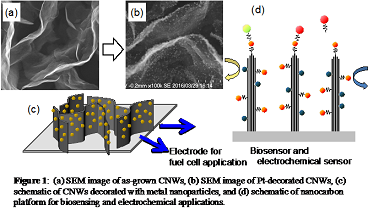
Mineo Hiramatsu
Meijo University, Japan
Title: Synthesis of vertical graphene network as platform for electrochemical applications
Biography
Biography: Mineo Hiramatsu
Abstract
Graphene based materials such as carbon nanotube and graphene sheet itself have a wide range of possible applications. Among these grapheme based materials, carbon nanowalls (CNWs) are self- supported network of few-layer graphenes standing almost vertically on the substrate to form 3-dimensional structure. The maze-like architecture of CNWs with large-surface area graphene planes would be useful as electrodes for energy storage devices, electrochemical and biosensors and scaffold for cell culturing. CNWs and related materials can be synthesized by several plasma enhanced chemical vapor deposition (PECVD) techniques on heated substrates employing CH4 and H2 mixtures. Control of CNW structures including spacing between adjacent nanowalls and crystallinity is significant for the practical applications. Moreover, surface functionalization including surface termination and decoration with catalytic metal nanoparticles should be established. We report the current status of fabrication and structure control of CNWs using several PECVD techniques. Moreover, CNW surface was decorated with Pt nanoparticles by the reduction of chloroplatinic acid or by the metal-organic chemical deposition employing supercritical fluid. We also report the performances of hydrogen peroxide (H2O2) sensor and fuel cell, where CNW electrode was used. For the H2O2 sensing application, CNWs were grown on carbon fiber paper (CFP) using PECVD with CH4/Ar mixture to increase the surface area. Then, CNW surface was decorated with Pt nanoparticles by the reduction of H2PtCl6 in solution. Cyclic voltammetry results showed that the Pt-decorated CNWs/CFP electrode exhibited excellent electrocatalytic activity to the reduction of H2O2. Similar structure was also used as a catalytic layer of the polymer electrolyte fuel cell. From the electrochemical investigation, Pt-decorated CNWs showed excellent electrochemical durability compared with the carbon black. Electrochemical experiments demonstrate that platform based on vertical nanographene offers great promise for providing a new class of nanostructured electrodes for electrochemical sensing and energy conversion applications.


